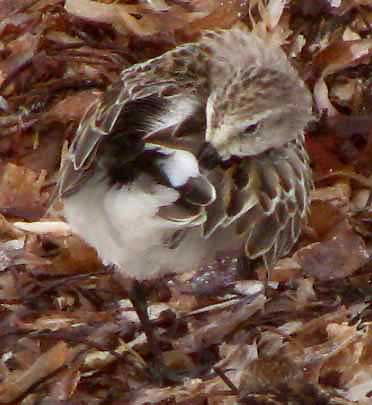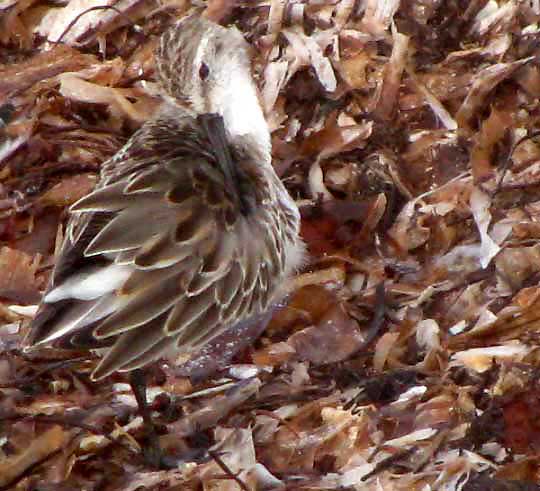Excerpts from Jim Conrad's
Naturalist Newsletter
from the September 18, 2011 Newsletter issued from Mayan Beach Garden Inn 20 kms north of Mahahual, Quintana Roo, México
PREENING

Above, that's a Western Sandpiper the bird shown poking his long beak into his tail area at the right.
That bird is beginning a period of preening by daubing his long beak onto his preen gland, or uropygial gland. The preen gland is a fleshy, small, oil producing, nipplelike nubbin typically at the base of a bird's back, about where shorter, fluffier back feathers yield to longer, stiffer tail feathers. During preening, birds smear oil from the gland onto their beaks or heads, then rub their beaks or heads over their bodies' feathers, oiling them up. The above sandpiper can be seen applying oil to his feathers below:

The oil helps waterproof feathers and may be important in controlling the bird's external parasites. The vast majority of birds have preen glands; emus, kiwis, ostriches, and bustards don't.
from the February 15, 2004 Newsletter issued from the woods near Natchez, Mississippi, USA
PREENING
Last week I reported a Thursday rain of 5 inches. From that Thursday morning until now we've received 10.6 inches (27 cm). That's left the ground so saturated that, I'm told, all over the county trees are toppling and mud slides are slumping onto roads. A couple of large trees in the woods here have succumbed as well.
The Carolina Wrens beneath my trailer have sometimes emerged into the rain, staying as neat and unruffled looking as if they were protected by magic shields. When a modest murder of crows alighted in a Water Oak, however, some appeared fine but others were disheveled, and obviously cold and wet. Some birds have dealt with this deluge better than others.
Occasionally the rain has paused long enough for me to walk around, to see how things were holding out. During these walks I've seen a lot of birds preening. After going so long without being able to eat normally, you might think that a bird's first priority would be to gorge itself. Instead, the rain seems to have made them yearn for running their beaks through their feathers, nibbling their feathers' bases, and scratching their heads. This reminds me that for any bird preening is serious business, sometimes even more important than eating.
Preening accomplishes two main jobs. First, it returns feathers to their right places. If you've ever faced spending a cold night in a down sleeping bag that has "lost its loft," you know how dramatically you can increase the bag's insulation capacity by giving it a good shaking and a paddling. Well arranged feathers keep the cold out, crunched together ones don't.
Just as important, preening involves oiling the feathers. If you watch a bird preening, occasionally you'll see it arch its head over its back, poke its tail skyward, and appear to bite something where its back joins its tail. When a bird does that, it's gathering oil from its "preen gland," more technically known as its uropygial gland. When a bird nibbles and combs its feathers with its beak smeared with uropygial oil it's not only arranging them, but also oiling them. Like oil rubbed onto leather boots, preening oil keeps feathers flexible, resilient and somewhat waterproof. Also it inhibits the growth of fungi and bacteria. In short, my Carolina Wrens do have a "magic shield" when it rains, and that shield is the consequence of preening with oil.